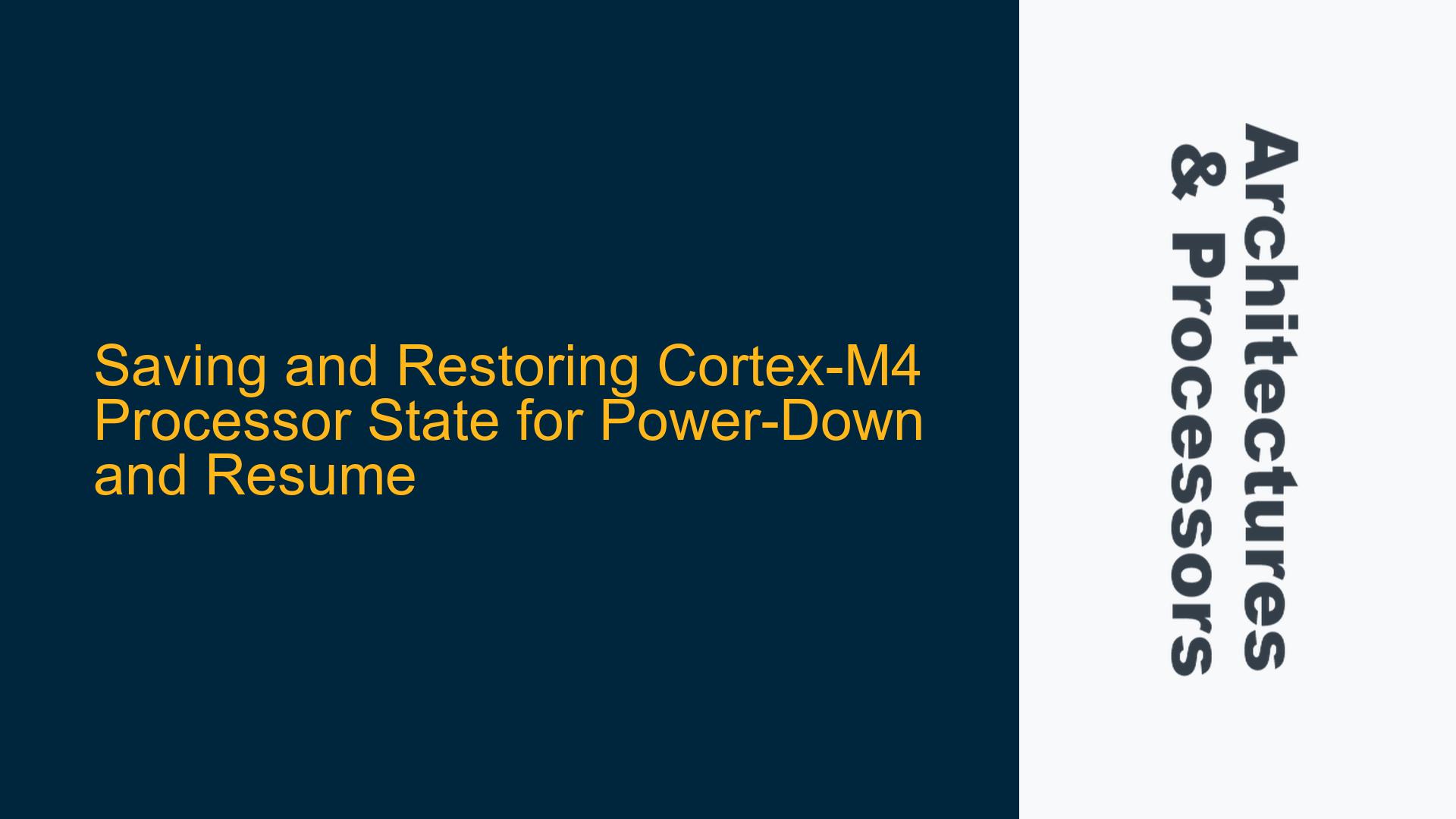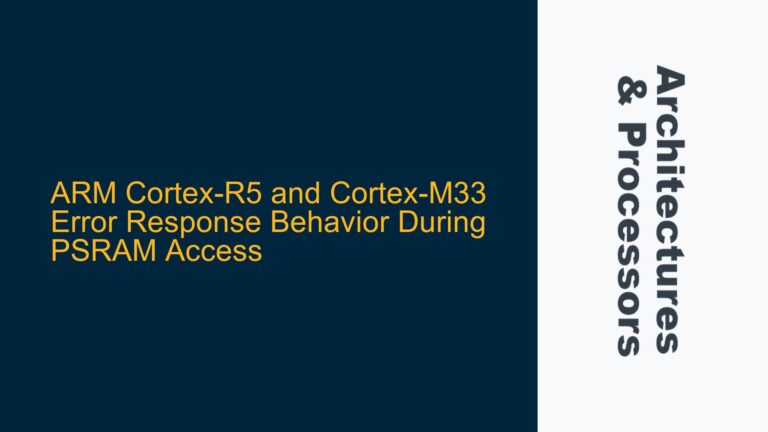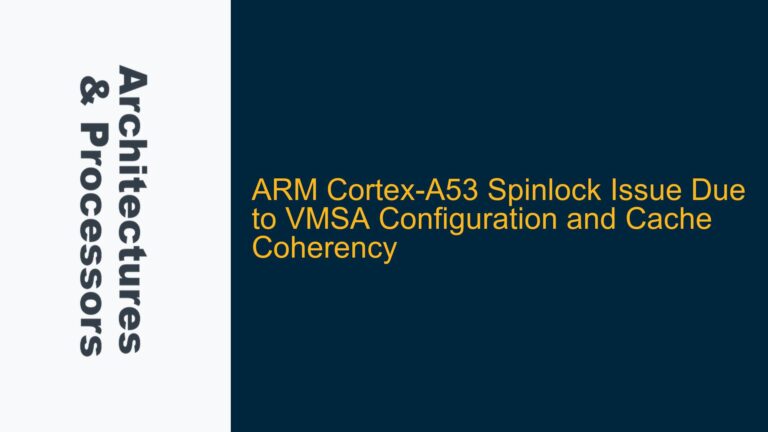Cortex-M4 Processor State Preservation Requirements During Power-Down
The Cortex-M4 processor, like many ARM cores, is designed for low-power applications where power-down and resume functionality is critical. When powering down the Cortex-M4 while retaining system RAM, the processor state must be saved to ensure a seamless restoration upon resumption. This involves preserving not only the core registers but also the system control registers, NVIC (Nested Vectored Interrupt Controller) state, SysTick timer, and other peripheral configurations. The challenge lies in identifying all the necessary registers and ensuring that their values are correctly stored and restored without corruption.
The Cortex-M4 Technical Reference Manual (TRM) provides a comprehensive list of registers, but it does not explicitly outline a step-by-step procedure for saving and restoring the processor state during power-down. This requires a deep understanding of the processor’s architecture, including the role of each register and the implications of their states on system behavior. For instance, the core registers (R0-R12, SP, LR, PC, xPSR) are straightforward, but system control registers like the CONTROL, FAULTMASK, and BASEPRI require careful handling due to their impact on exception handling and privilege levels.
Additionally, the NVIC state, which includes interrupt enable/disable flags and pending interrupt statuses, must be preserved to maintain the system’s interrupt handling capabilities. The SysTick timer, often used for real-time operating system (RTOS) tick generation, must also be saved and restored to ensure accurate timing upon resume. Peripheral configurations, which vary depending on the specific SoC implementation, may also need to be preserved, especially if they do not support sleep modes or retain their state during power-down.
Shadow Registers and Peripheral Sleep Modes in State Preservation
One of the primary challenges in saving the Cortex-M4 processor state is dealing with read-only (RO) registers and peripherals that do not retain their state during power-down. RO registers, such as certain status registers, cannot be directly written back during restoration. This necessitates the use of shadow registers—software-maintained copies of these RO registers that are updated during runtime and restored upon resume. Shadow registers add complexity to the state preservation process, as they require careful management to ensure consistency between the actual hardware state and the software-maintained shadow state.
Peripheral sleep modes further complicate the state preservation process. Some peripherals may support low-power sleep modes that retain their state, while others may lose their configuration entirely during power-down. For peripherals that do not support sleep modes, their state must be explicitly saved to RAM and restored upon resume. This requires a detailed understanding of the peripheral’s register map and the specific configurations that need to be preserved. For example, UART configurations, GPIO states, and timer settings may all need to be saved and restored to ensure the system resumes operation correctly.
The use of shadow registers and the handling of peripheral sleep modes are critical aspects of the state preservation process. Failure to properly manage these elements can lead to inconsistent system behavior, data corruption, or even system crashes upon resume. Therefore, a thorough analysis of the SoC’s peripheral capabilities and a well-defined strategy for managing shadow registers are essential for successful state preservation.
Implementing Cortex-M4 State Preservation and Restoration
Implementing state preservation and restoration on the Cortex-M4 involves a series of well-defined steps to ensure that all critical processor and peripheral states are saved and restored correctly. The first step is to identify all the registers and configurations that need to be preserved. This includes core registers, system control registers, NVIC state, SysTick timer, and peripheral configurations. The Cortex-M4 TRM provides a comprehensive list of registers, but additional documentation for the specific SoC may be required to identify peripheral-specific registers.
Once the registers and configurations have been identified, the next step is to implement the save and restore routines. The save routine involves writing the current state of the identified registers and configurations to a reserved area in RAM. This must be done in a specific order to ensure that no critical state is lost during the process. For example, the core registers should be saved first, followed by system control registers, NVIC state, and finally peripheral configurations. The use of data synchronization barriers (DSB) and instruction synchronization barriers (ISB) is recommended to ensure that all writes to RAM are completed before proceeding to the next step.
The restore routine involves reading the saved state from RAM and writing it back to the appropriate registers and configurations. This must also be done in a specific order to ensure that the system resumes operation correctly. For example, peripheral configurations should be restored first, followed by NVIC state, system control registers, and finally core registers. Again, the use of DSB and ISB instructions is recommended to ensure that all writes to the registers are completed before proceeding to the next step.
In addition to the save and restore routines, it is important to implement error handling and validation mechanisms to ensure that the state preservation and restoration process is robust. This includes checksum validation of the saved state, error recovery mechanisms in case of corruption, and logging mechanisms to track the state preservation and restoration process. These mechanisms are critical for ensuring the reliability and stability of the system during power-down and resume operations.
The following table summarizes the key registers and configurations that need to be preserved during power-down and resume on the Cortex-M4:
| Category | Registers/Configurations | Description |
|---|---|---|
| Core Registers | R0-R12, SP, LR, PC, xPSR | General-purpose registers, stack pointer, link register, program counter, and program status register. |
| System Control Registers | CONTROL, FAULTMASK, BASEPRI | Registers controlling exception handling, privilege levels, and priority masking. |
| NVIC State | Interrupt Enable/Disable, Pending Interrupts | State of the Nested Vectored Interrupt Controller, including interrupt enable/disable flags and pending interrupt statuses. |
| SysTick Timer | SYST_CSR, SYST_RVR, SYST_CVR | System timer registers used for real-time operating system tick generation. |
| Peripheral Configurations | UART, GPIO, Timers, etc. | Configuration registers for peripherals that do not support sleep modes or retain their state during power-down. |
In conclusion, saving and restoring the Cortex-M4 processor state during power-down and resume is a complex but essential task for low-power applications. It requires a thorough understanding of the processor’s architecture, careful management of shadow registers, and a well-defined strategy for handling peripheral sleep modes. By following the steps outlined above and implementing robust error handling and validation mechanisms, developers can ensure that their systems resume operation correctly and reliably after power-down.






